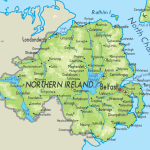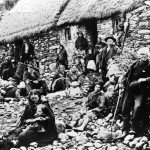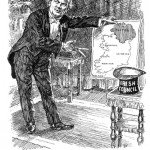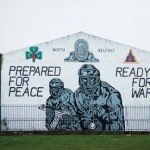
Northern Ireland is a place of natural beauty, mystery and Celtic charm. In recent times, however, the history of Northern Ireland has been marred by political tension, sectarian feuding and paramilitary killing. From the late 1960s the world watched in despair as Northern Ireland unravelled into unrest and violence. This period is euphemistically known as the Troubles. Trouble had in fact been brewing in Northern Ireland for generations. Created by the partition of Ireland in 1920, Northern Ireland was a society plagued by tension and division. On one side of the divide stood Unionists: staunchly Protestant, loyal to their British heritage and determined that Northern Ireland should remain part of the United Kingdom. On the other side were Northern Ireland’s Catholics, a minority that had endured decades of political and economic marginalisation. Caught in the middle, the British government was eager to achieve reconciliation and peace in Northern Ireland but was unsure how to achieve this. Paramilitary groups on both sides, like the Irish Republican Army (IRA) and Ulster Volunteer Force (UVF) operated outside the law, using violence and terrorism to impose their political will. For three decades these groups struggled for ascendancy as the Troubles in Northern Ireland raged. Their actions produced the deaths of more than 3,500 people, many of them civilians and innocent children caught in the crossfire.
To understand the Troubles, one must first understand the political and religious fault lines that run through Ireland’s history. The majority of Irish are Catholic, however English occupation and settlement in the 16th and 17th centuries left Ireland with a sizeable Protestant population. By the late 1600s the majority of land was owned by the Protestant Anglo-Irish, who became Ireland’s ruling class. Most of the nation’s Catholics remained as poor tenant-farmers. Repressive and discriminatory Penal Laws kept Catholics out of education, prestigious professions and government. In the late 1700s rising Irish nationalism called for greater autonomy for the Irish parliament. It also triggered uprisings like the Wolfe Tone rebellion, an unsuccessful attempt to drive the English from Ireland. London responded by crushing these rebellions and passing the 1800 Act of Union, which formed the United Kingdom and placed Ireland under British control. In the 19th century Irish Catholics fought to regain their rights, demanding emancipation and participation in their own government, a goal they achieved in 1829. Impoverished Irish Catholics suffered tremendously during the Great Famine of the 1840s; around one million starved to death and an even greater number fled the country in search of a better life.

Ireland’s political divisions hardened in the late 19th and early 20th century. The Irish Republican Brotherhood, the country’s first significant independence movement, was formed in 1858. Other more moderate Irish political parties also embraced nationalism. By the 1880s many Irish parliamentarians were lobbying for Home Rule, or Irish self government. But Home Rule was bitterly opposed by Anglo-Irish Protestants, most of whom were clustered in the north-east in what they called Ulster. Through trade and connections with Britain, Ulster’s Protestants had built up large and successful industries around Belfast. Home Rule, they argued, would place them under the heel of a Catholic parliament in Dublin and jeopardise their economic livelihood and political and religious freedom. But the push for Home Rule continued, regardless of Unionist opposition. Two late 19th century attempts to legislate Home Rule were defeated in the British parliament. A third Home Rule bill was introduced in 1912, this time with the support of the government. It triggered a crisis in the north-east, where Unionists formed a paramilitary group (the Ulster Volunteers) and threatened to take up arms to resist Home Rule. In early 1914 the Ulster Volunteers took delivery of a large cache of arms, purchased illegally from Germany. The implementation of Home Rule, it seemed, would trigger a civil war in Ireland.

The Home Rule legislation was passed in September 1914 but was immediately deferred, due to the outbreak of World War I. Most of Ireland’s Unionists and Nationalists set aside their domestic concerns to concentrate on the war against Germany. But radical Republicans, impatient with the lack of political reform in Ireland, decided to act. In April 1916 they launched the famous Easter Rising, capturing the post office in Dublin and proclaiming an independent Irish republic. British troops quickly crushed the uprising but it proved a turning point in Irish republicanism. The years following saw an surge in support for Sinn Fein, a fringe Republican party, and the newly formed IRA. In 1919 they formed an alternative government, declared an independent Irish republic and vowed to fight until the British were driven from Ireland. Meanwhile, in late 1920, the British government attempted to implement Home Rule by partitioning Ireland, separating six Protestant counties in Ulster from the rest of the country. Both Northern Ireland and Southern Ireland were given their own parliament, executive government and judiciary. Partition was intended to be a temporary measure but became permanent in 1922, when Northern Ireland severed all political ties with Dublin. Thus began the development of Northern Ireland and its southern neighbour as separate states. By 1948 the Free State had evolved into an independent republic, free of any obligations to London, while Northern Ireland remained an autonomous but loyal dominion of the United Kingdom.
Separation from Dublin did not end Northern Ireland’s sectarian problems. The lack of connection and common ground between Protestant and Catholic populations in Northern Ireland continued to cause problems. Decades of discriminatory and segregationist policies produced a society where Protestants and Catholics lived in separate areas, were educated in different schools, employed in different workplaces and drank in different pubs. Even in crowded cities like Belfast and Derry, most Protestants and Catholics lived their lives without significant interaction. This segregation, however, only deferred contact and sectarian conflict. The flashpoint for confrontation between Northern Ireland’s Protestants and Catholics came in the mid to late 1960s. In Western countries like the United States, South Africa and Australia, racial and religious minorities were mobilising and crying out for rights and equality. Inspired by these movements, Northern Ireland’s Catholics initiated their own struggle for civil rights, protesting against discriminatory housing allocations, unfair employment conditions, voting restrictions and electoral gerrymandering. The formation of the Northern Ireland Civil Rights Association (NICRA) in 1967 gave this movement organisation and leadership. On the other side of the line, Unionists interpreted the civil rights movement as a threat to their heritage, privileged position and political dominance.
The first significant violence of the Troubles erupted in Bogside, Derry in 1969. In August rioting in Derry exploded into a fully fledged street war – the ‘Battle of the Bogside’ – between Nationalists, Loyalists and the Royal Ulster Constabulary (RUC). This fighting left eight dead and almost 800 injured. Violence continued across Northern Ireland for the next two years, leading to the rise of paramilitary groups and the deployment of British soldiers. On January 30th 1972 British paratroopers opened fire on civilian protesters in Derry, killing 14 civilians. Bloody Sunday, as it became known, caused outrage across Ireland and indeed the world. With Northern Ireland descending into anarchy, London dissolved the government in Belfast and introduced Direct Rule. Meanwhile the IRA, now split into two, continued to grow, equip and mobilise. Loyalists too formed paramilitary groups to protect their communities and suppress Catholic and Nationalist discontent. In 1971 the secretive and well drilled Provisional IRA declared war on British soldiers and RUC officers, doing its best to drive out the British and make Northern Ireland ungovernable. In the mid 1970s the IRA exported its fight against the British to Britain itself, where volunteers bombed military facilities, infrastructure, financial areas and even shopping districts.
“The Northern Ireland conflict, more familiarly called the Troubles, is one of the longest and most entangled confrontations in recent history. For nearly four decades now it has embittered relations between and within the communities living there and spoiled relations between the Republic of Ireland and Great Britain, while also causing severe strains within the latter. For three decades it escalated, punctuated by periodic bloody clashes followed by somewhat calmer periods of tension, during which violence of all sorts, robberies, kidnappings, serious injuries and deaths were all too common.
Gordon Gillespie, historian
For outsiders, the Troubles in Northern Ireland was a horrific media parade of bombings, civilian casualties, bloodthirsty assassinations and destructive riots. But the story of the Troubles is also the story of how to find peace in what seemed an endless and irresolvable conflict. While thugs and radicals wanted to shape Ireland’s future at the point of a gun, others strived to find resolution and peace, an infinitely more difficult battle. There were many failed attempts at peace: temporary ceasefires, disastrous peace talks, broken promises and shattered agreements. In the end it took the involvement of Sinn Fein, the IRA and moderate Unionists, as well as several world leaders, to craft a productive and optimistic peace process. The culmination of this process was the 1998 Good Friday Agreement, a commitment to a more collaborative, more inclusive and more democratic Northern Ireland. But there were too many compromises in the Good Friday Agreement for it to please everyone. Even as the ink was drying on this historic document, some vowed to destroy it.

Northern Ireland today seems to have travelled well down the road to peace. Derry, once an anarchic place wracked by violent riots, is now a UK City of Culture. Belfast, where once only the bravest traveller might have ventured, now hums and bustles with tourists. Yet reminders of the Troubles still scar the majestic landscape and busy urban areas of Northern Ireland. Visitors walking the small streets of Belfast and Derry encounter memorial gardens to the victims of paramilitary violence. Buildings and walls are bedecked with colourful murals painted by talented local artists. Some of these murals recall significant events of the Troubles, like the civil rights marches and Bloody Sunday. Some are markers of political allegiance; some are tributes to dead paramilitary fighters; some are heartbreaking memorials to murdered children. Just a few feet from where British soldiers gunned down civilians in 1972, the Museum of Free Derry houses images and artefacts of the early years of the Troubles. In English cities too, plaques and memorials remember IRA bombings and their victims, many of them children. All of these symbols contribute to the peace process by serving as a constant reminder of the real cost of war. They also remind the people of Northern Ireland that peace is not an achievement of the past, but an ongoing struggle for the future.

1. Summary point
2. Summary point
3. Summary point
4. Summary point
5. Summary point

© Alpha History 2016. Content on this page may not be republished or distributed without permission. For more information please refer to our Terms of Use.
This page was written by Rebekah Poole and Jennifer Llewellyn. To reference this page, use the following citation:
R. Poole & J. Llewellyn, “A summary of the Troubles in Northern Ireland”, Alpha History, accessed [today’s date], https://alphahistory.com/northernireland/summary-troubles-northern-ireland/
